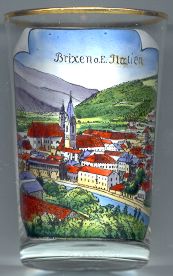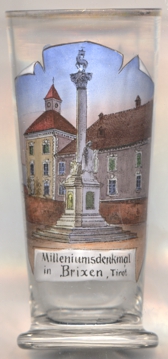

|
| ITALIA | ITALY |
| autonome Region: Trentino-Südtirol / regione autonoma: Trentino-Alto Adige | Trentino – South Tyrol |
| autonome Provinz: Bozen – Südtirol / provincia autonoma: Bolzano – Alto Adige |
Brixen (Italian: Bressanone, Ladin: Porsenù; until 1919 German Brixen am Eisack) is situated at an elevation of 560 m at the confluence of the rivers Eisack (Isarco) and Rienz (Rienza). It is one of the oldest towns in historic Tyrol, the centre of the Eisack valley and, at a population of about 22,400, the third largest town of South Tyrol.
The area of Brixen has been settled since the Upper Paleolithic (8th millennium BC). Other settlements from the late Stone Age have been found and in 15 BC, the area was conquered by the Romans, who had their main settlement in the nearby Säben (Sabiona). They held it until around 590, when it was occupied by Bavarians. The first mention of Brixen dates to 901 in a document that assigned a territory called Prihsna the bishop of Säben. The bishops moved here from Säben in 992, after the cathedral had been finished. In 1039, the Bishop of Brixen, Poppo, was elevated to Pope (Damasus II) by emperor Heinrich III; however, his reign lasted for only 23 days. Yet in the same century, Brixen became the seat of an independent ecclesiastical principate which, in the following years, struggled for existence against the neighbouring county of Tyrol. From 1027 until 1803, the bishops were also styled princes of the Holy Roman Empire. The bishopric was secularized in 1803 and annexed by the Austrian Empire. Around 1900 Brixen became one of the most important spa towns in South Tyrol next to Meran (Merano). After the end of World War I, South Tyrol was annexed by Italy. Upon the installation of the diocese of Innsbruck in 1964, the seat of the bishops of Brixen was transferred to Bozen (Bolzano).
 The
The  cathedral Mariä Aufnahme in den Himmel und Sankt Kassian (Assumption of the Virgin Mary
and Saint Cassian of Imola) [left, no. 4581: top picture: centre] goes back to a Romanesque cathedral
that was built when Brixen became the seat of the bishops in 960/970. The original west choir was demolished in the 12th century
to be replaced by the two west towers. After a large fire had destroyed the church in 1174, it was rebuilt in High Romanesque
style and consecrated in 1237. During the Gothic period several chapels were added. The High Gothic choir replaced the
former eastern apse under bishop Nikolaus of Kues (Nicolaus Cusanus, bishop 1450–1464). The Romanesque north tower
was rebuilt in early Baroque style in 1610–1613, the south tower was rebuilt to match in 1748. The present appearance
of the church was created when it was rebuilt in splendid Baroque style in 1745–1758. Fifty different kinds of marble
were used for the interior decorations. The magnificent ceiling paintings were executed by the famous Austrian painter Paul
Troger. Although the seat of the bishop in 1964 was moved to Bozen (Bolzano), the church retained
its status of a cathedral, with the church of the Ascension of Our Lady of Bozen as co-cathedral. The church was granted the
Papal title of a Basilica minor in 1950.
cathedral Mariä Aufnahme in den Himmel und Sankt Kassian (Assumption of the Virgin Mary
and Saint Cassian of Imola) [left, no. 4581: top picture: centre] goes back to a Romanesque cathedral
that was built when Brixen became the seat of the bishops in 960/970. The original west choir was demolished in the 12th century
to be replaced by the two west towers. After a large fire had destroyed the church in 1174, it was rebuilt in High Romanesque
style and consecrated in 1237. During the Gothic period several chapels were added. The High Gothic choir replaced the
former eastern apse under bishop Nikolaus of Kues (Nicolaus Cusanus, bishop 1450–1464). The Romanesque north tower
was rebuilt in early Baroque style in 1610–1613, the south tower was rebuilt to match in 1748. The present appearance
of the church was created when it was rebuilt in splendid Baroque style in 1745–1758. Fifty different kinds of marble
were used for the interior decorations. The magnificent ceiling paintings were executed by the famous Austrian painter Paul
Troger. Although the seat of the bishop in 1964 was moved to Bozen (Bolzano), the church retained
its status of a cathedral, with the church of the Ascension of Our Lady of Bozen as co-cathedral. The church was granted the
Papal title of a Basilica minor in 1950.
(see also list of other basilicae minores depicted on glasses of this collection)
The sanatorium  Heilanstalt
Heilanstalt
 Krakofl castle [left, no. 4581: bottom picture: background right] was originally built around
1320. The old castle burnt down in 1809. It took until 1869 that it was rebuilt, in Historistic style, as a private home. Some alterations were made
in 1970.
Krakofl castle [left, no. 4581: bottom picture: background right] was originally built around
1320. The old castle burnt down in 1809. It took until 1869 that it was rebuilt, in Historistic style, as a private home. Some alterations were made
in 1970.


The  parish and deanery church of Sankt Michael [left, no. 0000: centre, and right no. 1468: centre]
next to the cathedral is dedicated to the Archangel Michael. The late Gothic hall church was built around 1500 in place of an older, Romanesque
church that had been consecrated in 1038. The lower parts of the tower date from around 1300, the upper parts were
completed in 1459. The interior was remodeled in Baroque style around 1750.
parish and deanery church of Sankt Michael [left, no. 0000: centre, and right no. 1468: centre]
next to the cathedral is dedicated to the Archangel Michael. The late Gothic hall church was built around 1500 in place of an older, Romanesque
church that had been consecrated in 1038. The lower parts of the tower date from around 1300, the upper parts were
completed in 1459. The interior was remodeled in Baroque style around 1750.

The  Jahrtausendsäule (Millennium Column) [near left, no. 4078: foreground] was originally
commissioned for the celebration of the anniversary of the first known written mention of Brixen, dating from 901. However, financial troubles delayed
its completion so that the monument, created by the sculptor Norbert Pfretzschner was only inaugurated in 1909 on the occasion of the centenary of the
Tyrolean struggle for freedom. The column is crowned by the sculpture of the Easter Lamb, the heraldic animal of the diocese and the city.
Jahrtausendsäule (Millennium Column) [near left, no. 4078: foreground] was originally
commissioned for the celebration of the anniversary of the first known written mention of Brixen, dating from 901. However, financial troubles delayed
its completion so that the monument, created by the sculptor Norbert Pfretzschner was only inaugurated in 1909 on the occasion of the centenary of the
Tyrolean struggle for freedom. The column is crowned by the sculpture of the Easter Lamb, the heraldic animal of the diocese and the city.
The  Hofburg (Residence of the Prince Bishops) [near left, no. 4078: background] goes back to a
castle built by the bishops in 1265 as their residence. This old castle was enlarged in the 15th and 16th centuries. The present residence castle
was built between 1595 and 1645 in Renaissance style. In 1701–1711 the residence was enlarged and remodeled in Baroque style. When the secular
power of the prince bishops ended in 1803, the residence came in possession of the Austrian state, which, however, allowed the bishops to continue to
use it as their seat. In 1828 the complex was returned into the possession of the diocese of Brixen. Since 1964, when the bishops moved their
residence to Bozen / Bolzano, the buildings are used as diocesan museum and archives.
Hofburg (Residence of the Prince Bishops) [near left, no. 4078: background] goes back to a
castle built by the bishops in 1265 as their residence. This old castle was enlarged in the 15th and 16th centuries. The present residence castle
was built between 1595 and 1645 in Renaissance style. In 1701–1711 the residence was enlarged and remodeled in Baroque style. When the secular
power of the prince bishops ended in 1803, the residence came in possession of the Austrian state, which, however, allowed the bishops to continue to
use it as their seat. In 1828 the complex was returned into the possession of the diocese of Brixen. Since 1964, when the bishops moved their
residence to Bozen / Bolzano, the buildings are used as diocesan museum and archives.
[https://de.wikipedia.org/wiki/Brixen, https://en.wikipedia.org/wiki/Brixen;
https://de.wikipedia.org/wiki/Diözese_Bozen-Brixen;
https://de.wikipedia.org/wiki/Brixner_Dom, https://de.wikipedia.org/wiki/Nikolaus_von_Kues,
https://de.wikipedia.org/wiki/Liste_der_Basiliken_in_den_deutschsprachigen_Ländern;
https://de.wikipedia.org/wiki/Pfarrkirche_St._Michael_(Brixen);
https://www.hiwio.com/de/Artikel/Die-Jahrtausends%C3%A4ule-in-Brixen-84;
https://de.wikipedia.org/wiki/Hofburg_(Brixen);
https://www.rainews.it/tgr/tagesschau/articoli/2023/12/brixen-das-wird-aus-dem-kurhaus-von-guggenberg--1952a012-bbf9-4d48-8140-e2ba7a3e4315.html;
https://www.alleburgen.de/bd.php?id=28550]
![[scale]](lineal.jpg)